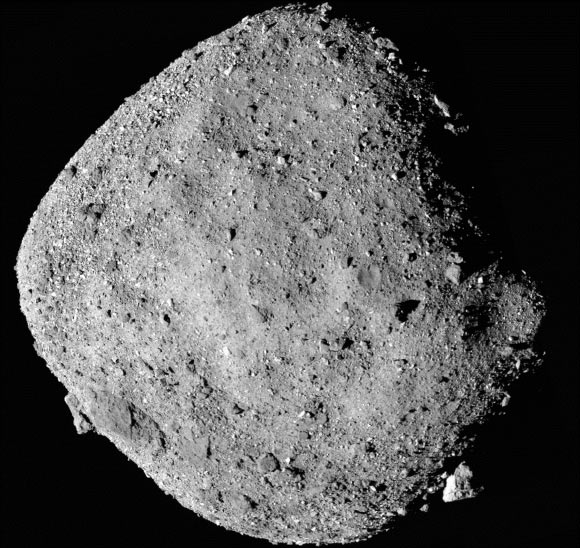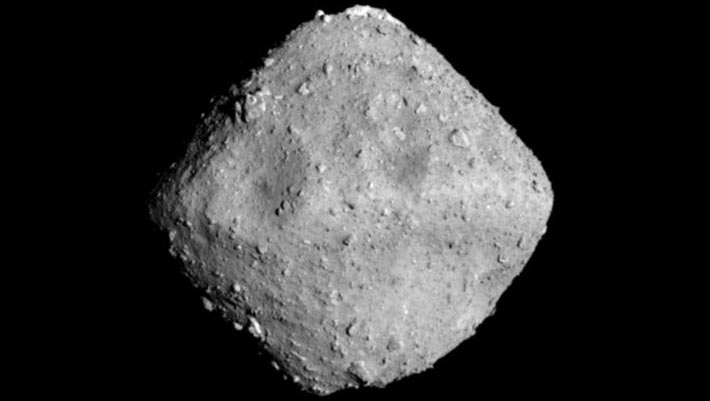The new Polana collisional family in the Solar System’s main asteroid belt is the hypothesized origin of the near-Earth asteroids (101955) Bennu, which was the target of NASA’s OSIRIS-REx mission, and (162173) Ryugu, which was the target of JAXA’s Hayabusa-2 mission. Now, astronomers using the NASA/ESA/CSA James Webb Space Telescope have obtained spectroscopic data from the parent body of the family, (142) Polana, and compared them with spacecraft and laboratory data of both near-Earth asteroids, discovering similarities in their near-infrared spectra sufficient to support the theory that they originate from the same parent asteroid.
This image of the asteroid Ryugu was captured by the Optical Navigation Camera – Telescopic (ONC-T) on JAXA’s Hayabusa-2 spacecraft on June 26, 2018, from a distance of 13.7 miles (22 km). Image credit: JAXA / University of Tokyo / Kochi University / Rikkyo University / Nagoya University / Chiba Institute of Technology / Meiji University / Aizu University / AIST.
“Very early in the formation of the Solar System, we believe large asteroids collided and broke into pieces to form an ‘asteroid family’ with Polana as the largest remaining body,” said Dr. Anicia Arredondo, a researcher at the Southwest Research Institute.
“Theories suggest that remnants of that collision not only created Polana, but also Bennu and Ryugu as well.”
“To test that theory, we started looking at spectra of all three bodies and comparing them to one another.”
The authors applied for time on Webb to observe Polana using two different spectral instruments focusing on the near-infrared and mid-infrared wavelengths.
They then compared that data with the spectral data from physical samples of Ryugu and Bennu collected by two different space missions.
“Bennu and Ryugu are considered near-Earth asteroids because they orbit the Sun within the orbit of Mars,” they said.
“However, they are not considered a danger to Earth, having a closest approach of about 3 million km (1.9 million miles) and 1.6 million km (1 million miles), respectively.”
“Both Bennu and Ryugu are relatively small compared to Polana. Bennu is about 500 m (0.3 miles) in diameter, or about the size of the Empire State Building.”
“Ryugu is twice as large, but Polana dwarfs them both, measuring roughly 55.3 km (34.4 miles) wide.”
“Scientists believe Jupiter’s gravity pushed Bennu and Ryugu out of their orbit close to Polana.”
“They are similar enough that we feel confident that all three asteroids could have come from the same parent body.”

This mosaic image of asteroid Bennu is composed of 12 images collected on December 2, 2018 by OSIRIS-REx’s PolyCam instrument from a range of 15 miles (24 km). Image credit: NASA / NASA’s Goddard Space Flight Center / University of Arizona.
The authors noted that the spectral data from the asteroids had variances and differences, but not enough to disprove the hypothesis that they all share a common origin.
“Polana, Bennu and Ryugu have all had their own journeys through our solar system since the impact that may have formed them,” said Dr. Tracy Becker, also from the Southwest Research Institute.
“Bennu and Ryugu are now much closer to the Sun than Polana, so their surfaces may be more affected by solar radiation and solar particles.”
“Likewise, Polana is possibly older than Bennu and Ryugu and thus would have been exposed to micrometeoroid impacts for a longer period.”
“That could also change aspects of its surface, including its composition.”
A paper on the findings was published in the Planetary Science Journal.
_____
Anicia Arredondo et al. 2025. JWST Spectroscopy of (142) Polana: Connection to NEAs (101955) Bennu and (162173) Ryugu. Planet. Sci. J 6, 195; doi: 10.3847/PSJ/ade395
